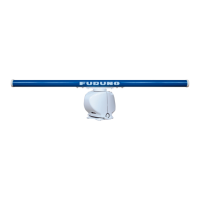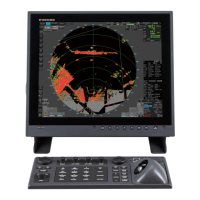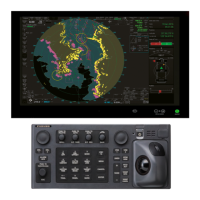Do you have a question about the Furuno FAR-3230S and is the answer not in the manual?
Warning about harmful electromagnetic radio frequency (RF) energy emitted by the radar antenna.
Information about warning labels attached to the equipment and how to obtain replacements.
Procedure for powering the system on and off, including warm-up times and settings preservation.
Procedure for transmitting radar pulses, including standby and transmit states.
Details on automatic target acquisition, including enabling and setting acquisition zones.
Procedures for canceling tracking on individual or all targets.
Detailed steps for entering marks and lines into the radar map, including selection and saving.
Procedure for installing public keys to authenticate ENC chart materials.
Steps for installing ENC licenses and charts, including automatic and manual installation.
Instructions for installing C-MAP charts, including eToken registration and database installation.
Setting depth values for contours to define safe and unsafe water areas.
Troubleshooting common issues with C-MAP software or chart installation.
Explanation of chart alerts, including depth contours and operator-selectable objects.
Setting up a check area around own ship to calculate predicted movement and activate alerts.
Overview of the route monitor function for safe route checking and user chart linking.
Definition of a route plan, its components, and main planning functions.
Step-by-step guide to creating a new route, including waypoint definition and data editing.
Explanation of available route optimization strategies for improved navigation.
Instructions for creating a new user chart, including object selection and placement.
Procedure for starting route monitoring using the InstantAccess bar or Route Information box.
Utilizing Instant Track feature for temporary deviations or returning to a monitored route.
Feature to check ship's drifting while at anchor, with alarm settings.
Functionality for sending and receiving AIS safety messages via VHF link.
Procedures for recording user events and position events, including manual input.
Storing information about dangerous radar and AIS targets, and how to view the log.
Definition of alerts, their classification by priority and category.
Description of the Alert box, including alert state icons, messages, and buzzer control.
Setting basic ship parameters and route parameters for navigation system function.
Common radar and chart troubleshooting procedures for restoring normal operation.
Warning about harmful electromagnetic radio frequency (RF) energy emitted by the radar antenna.
Information about warning labels attached to the equipment and how to obtain replacements.
Procedure for powering the system on and off, including warm-up times and settings preservation.
Procedure for transmitting radar pulses, including standby and transmit states.
Details on automatic target acquisition, including enabling and setting acquisition zones.
Procedures for canceling tracking on individual or all targets.
Detailed steps for entering marks and lines into the radar map, including selection and saving.
Procedure for installing public keys to authenticate ENC chart materials.
Steps for installing ENC licenses and charts, including automatic and manual installation.
Instructions for installing C-MAP charts, including eToken registration and database installation.
Setting depth values for contours to define safe and unsafe water areas.
Troubleshooting common issues with C-MAP software or chart installation.
Explanation of chart alerts, including depth contours and operator-selectable objects.
Setting up a check area around own ship to calculate predicted movement and activate alerts.
Overview of the route monitor function for safe route checking and user chart linking.
Definition of a route plan, its components, and main planning functions.
Step-by-step guide to creating a new route, including waypoint definition and data editing.
Explanation of available route optimization strategies for improved navigation.
Instructions for creating a new user chart, including object selection and placement.
Procedure for starting route monitoring using the InstantAccess bar or Route Information box.
Utilizing Instant Track feature for temporary deviations or returning to a monitored route.
Feature to check ship's drifting while at anchor, with alarm settings.
Functionality for sending and receiving AIS safety messages via VHF link.
Procedures for recording user events and position events, including manual input.
Storing information about dangerous radar and AIS targets, and how to view the log.
Definition of alerts, their classification by priority and category.
Description of the Alert box, including alert state icons, messages, and buzzer control.
Setting basic ship parameters and route parameters for navigation system function.
Common radar and chart troubleshooting procedures for restoring normal operation.
| Brand | Furuno |
|---|---|
| Model | FAR-3230S |
| Category | Marine Radar |
| Language | English |











